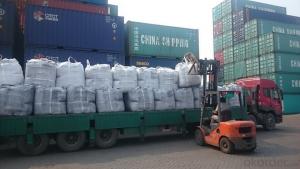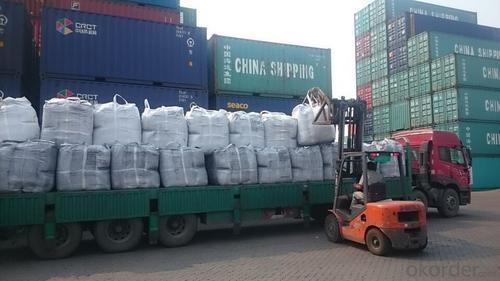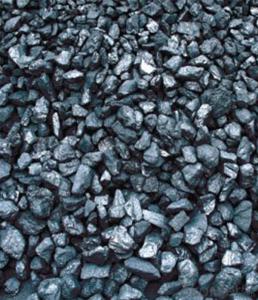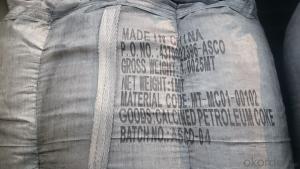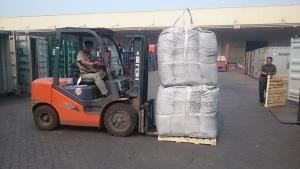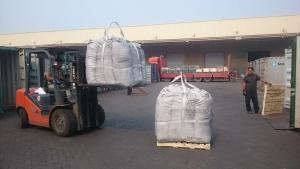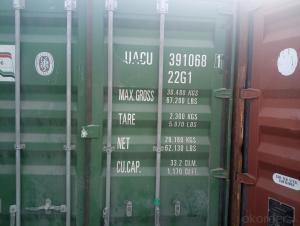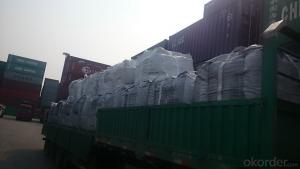Used in EAF as Charge Coke for Steel Plants with S 0.25%max
- Loading Port:
- Tianjin
- Payment Terms:
- TT OR LC
- Min Order Qty:
- 21 m.t.
- Supply Capability:
- 6000 m.t./month
OKorder Service Pledge
OKorder Financial Service
You Might Also Like
Introduction:
Calcined anthracite can be called carbon additive, carbon raiser, recarburizer, injection coke, charging coke, gas calcined anthracite.
Carbon Additive/Calcined Anthracite Coal may substitute massively refinery coke or graphite. Meanwhile its cost is much less than the refinery coke and graphite. Carbon Additive is mainly used in electric steel ovens, water filtering, rust removal in shipbuilding and production of carbon material.
It has good characteristics with low ash, low resistivity, low sulphur, high carbon and high density. It is the best material for high quality carbon products. It is used as carbon additive in steel industry or fuel.
Features:
Best quality Taixi anthracite as raw materials through high temperature calcined at 800-1200 ℃ by the DC electric calciner with results in eliminating the moisture and volatile matter from Anthracite efficiently, improving the density and the electric conductivity and strengthening the mechanical strength and anti-oxidation, It has good characteristics with low ash, low resistivity, low carbon and high density. It is the best material for high quality carbon products, it is used as carbon additive in steel industry or fuel.
Specifications:
F.C.% | 95MIN | 94MIN | 93MIN | 92MIN | 90MIN | 85MIN | 84MIN |
ASH % | 4MAX | 5MAX | 6 MAX | 6.5MAX | 8.5MAX | 12MAX | 13MAX |
V.M.% | 1 MAX | 1MAX | 1.0MAX | 1.5MAX | 1.5MAX | 3 MAX | 3 MAX |
SULFUR % | 0.3MAX | 0.3MAX | 0.3MAX | 0.35MAX | 0.35MAX | 0.5MAX | 0.5MAX |
MOISTURE % | 0.5MAX | 0.5MAX | 0.5MAX | 0.5MAX | 0.5MAX | 1MAX | 1MAX |
Pictures
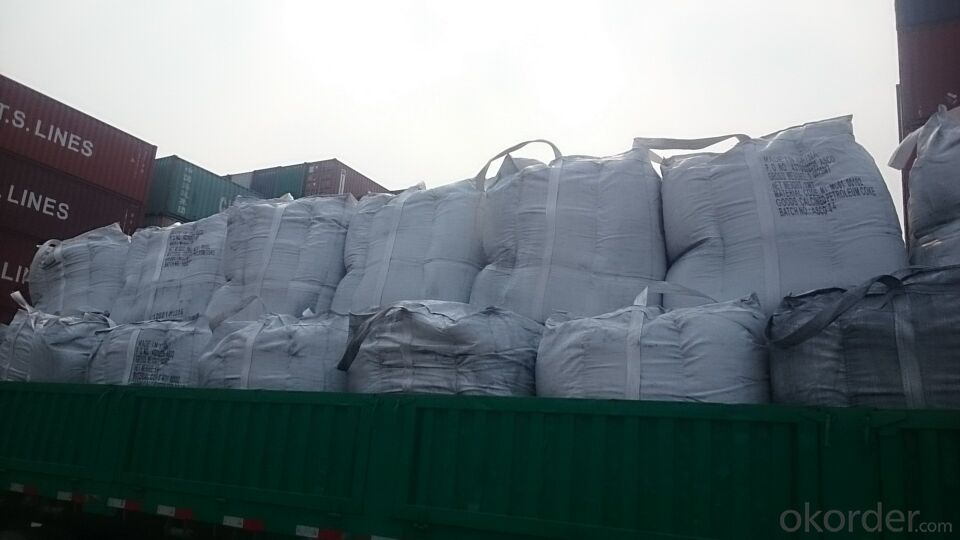

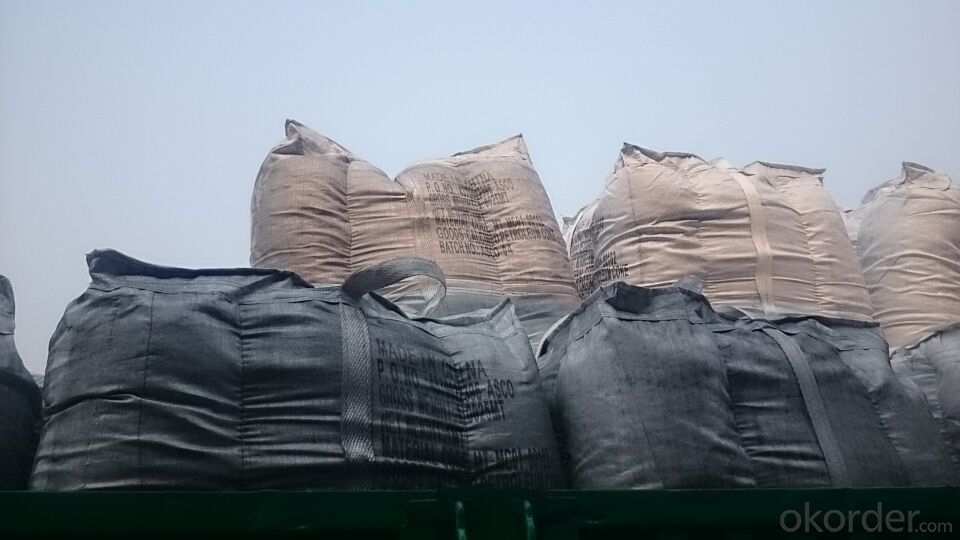
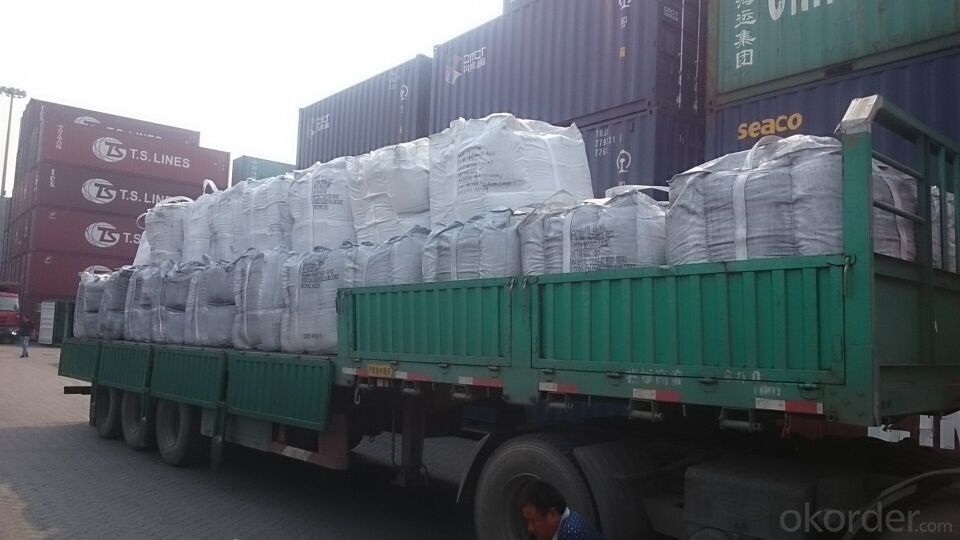
FAQ:
Packing:
(1). Waterproof jumbo bags: 800kgs~1100kgs/ bag according to different grain sizes;
(2). Waterproof PP woven bags / Paper bags: 5kg / 7.5kg / 12.5kg / 20kg / 25kg / 30kg / 50kg small bags;
(3). Small bags into jumbo bags: waterproof PP woven bags / paper bags in 800kg ~1100kg jumbo bags.
Payment terms
20% down payment and 80% against copy of B/L.
Workable LC at sight,
- Q: What is the starting temperature and final forging temperature of carbon steel?
- Forging temperature range refers to a temperature interval between the initial forging temperature and forging temperature. To determine the basic principles of forging temperature, can ensure that the metal has a high plasticity and low deformation resistance in the forging temperature range, and organization and performance requirements.
- Q: How does deforestation contribute to carbon dioxide levels in the atmosphere?
- Deforestation contributes to carbon dioxide levels in the atmosphere primarily through the release of stored carbon in trees and vegetation. When forests are cut down or burned, the carbon stored in their biomass is released as carbon dioxide, a greenhouse gas. Additionally, trees play a crucial role in absorbing carbon dioxide during photosynthesis, so their removal reduces the capacity to remove this greenhouse gas from the atmosphere. Therefore, deforestation not only releases carbon dioxide but also diminishes the natural carbon sinks, leading to an overall increase in carbon dioxide levels in the atmosphere.
- Q: How does carbon dioxide contribute to ocean acidification?
- Ocean acidification is caused by the presence of carbon dioxide, which forms carbonic acid when it dissolves in seawater. This reaction results in an increase in hydrogen ions and a decrease in pH, making the water more acidic. Human activities, especially the burning of fossil fuels, are leading to a rise in carbon dioxide emissions. As a result, more carbon dioxide is being absorbed by the oceans, disrupting the natural balance between atmospheric and oceanic carbon dioxide levels. This excess absorption leads to an accumulation of carbon dioxide in the seawater. The increased acidity of the seawater poses a significant threat to marine life. Many organisms, such as corals, shellfish, and certain types of plankton, rely on calcium carbonate to construct their shells or skeletons. However, in more acidic water, the availability of carbonate ions, necessary for calcium carbonate formation, decreases. Consequently, these organisms struggle to build and maintain their protective structures, rendering them more susceptible to predation and other dangers. Ocean acidification also has adverse effects on the growth, development, and behavior of numerous other marine species. For example, it can disrupt fish reproductive cycles and alter the behavior of certain species, making them more vulnerable to predators or adversely affecting their ability to locate food or mates. Moreover, ocean acidification can trigger a chain reaction that impacts entire marine ecosystems. The interconnectedness of species in complex food webs means that any disturbance to one species can have far-reaching consequences for others. If the population of a particular fish species declines due to acidification, it can have a ripple effect on the entire food chain, influencing the abundance and distribution of other species. In conclusion, the process of ocean acidification occurs as carbon dioxide dissolves in seawater and forms carbonic acid, resulting in an increase in hydrogen ions and a decrease in pH. This process has detrimental effects on marine organisms, particularly those reliant on calcium carbonate for their shells or skeletons. It also disrupts the growth, development, and behavior of various marine species and can have cascading impacts on entire ecosystems.
- Q: How does carbon impact soil health?
- Carbon is essential for maintaining soil health as it acts as a key component of organic matter. It helps improve soil structure, water holding capacity, and nutrient availability, thereby promoting the growth of beneficial soil microorganisms and enhancing overall soil fertility.
- Q: How can individuals reduce their carbon footprint?
- Individuals can reduce their carbon footprint by adopting sustainable lifestyle choices such as conserving energy, using public transportation or carpooling, eating a plant-based diet, reducing waste, and supporting renewable energy sources. Additionally, individuals can also make a difference by planting trees, supporting eco-friendly products, and spreading awareness about climate change.
- Q: How does carbon impact the ozone layer?
- Carbon does not directly impact the ozone layer. However, certain carbon compounds, such as chlorofluorocarbons (CFCs), can contribute to ozone depletion when released into the atmosphere.
- Q: What are the implications of melting permafrost on carbon emissions?
- The implications of melting permafrost on carbon emissions are significant and concerning. Permafrost refers to the permanently frozen ground found in cold regions, consisting of soil, rocks, and organic matter. It acts as a large carbon sink, storing vast amounts of organic material, such as dead plants and animals, which have been frozen for thousands of years. However, with rising global temperatures, permafrost is thawing at an alarming rate, leading to potential release of this stored carbon into the atmosphere. When permafrost thaws, the organic matter within it decomposes, releasing greenhouse gases, particularly carbon dioxide (CO2) and methane (CH4), into the atmosphere. Methane is an especially potent greenhouse gas, with a global warming potential over 25 times greater than that of CO2 over a 100-year period. The release of these gases further contributes to climate change, exacerbating the already accelerating warming trend. The implications of melting permafrost on carbon emissions are twofold. Firstly, the release of large amounts of CO2 and methane from thawing permafrost can significantly amplify the greenhouse effect, leading to more rapid and intense climate change. This can result in a feedback loop, where increased warming causes more permafrost thawing, releasing more carbon, and further accelerating global warming. Secondly, the release of carbon from permafrost also affects global carbon budgets and climate change mitigation efforts. The stored carbon in permafrost is estimated to be twice as much as is currently present in the Earth's atmosphere. As this carbon is released, it adds to the overall carbon emissions, making it more challenging to achieve emission reduction targets outlined in international agreements, such as the Paris Agreement. It also means that efforts to limit global warming to well below 2 degrees Celsius above pre-industrial levels become even more crucial. Furthermore, the release of carbon from permafrost also impacts local ecosystems and communities. Thawing permafrost can lead to the destabilization of infrastructure, including buildings, roads, and pipelines, as well as the disruption of traditional livelihoods, such as hunting and reindeer herding. It can also cause land subsidence and increased coastal erosion, threatening coastal communities and biodiversity. In conclusion, the implications of melting permafrost on carbon emissions are far-reaching. It not only exacerbates climate change by releasing potent greenhouse gases into the atmosphere but also hampers global efforts to mitigate carbon emissions. Sustainable actions to reduce greenhouse gas emissions and protect permafrost ecosystems are crucial to minimize these implications and safeguard our planet's future.
- Q: How are carbon nanotubes used in various industries?
- Carbon nanotubes are used in various industries for their exceptional properties. In electronics, they are utilized for creating smaller and faster transistors and memory devices. In materials science, they enhance the strength and conductivity of composites used in aerospace and automotive sectors. They also find applications in energy storage, where they improve the efficiency of batteries and supercapacitors. Additionally, carbon nanotubes are employed in medicine for drug delivery systems and as biosensors for detecting diseases. Overall, their versatility makes them valuable in multiple industries for enhancing performance and enabling innovative technologies.
- Q: How is carbon used in the water treatment process?
- The water treatment process employs carbon in various ways. Activated carbon, which possesses a high porosity and a large surface area, is commonly utilized. This enables it to efficiently adsorb and eliminate impurities from water. Water treatment facilities often employ activated carbon in the form of granules, pellets, or blocks. It can be introduced at different stages of the treatment process. For instance, during the initial filtration stage, activated carbon can be utilized to eliminate particles that can affect the water's taste and smell, such as sediment and chlorine byproducts. Moreover, activated carbon is highly effective in eliminating organic compounds, including pesticides, herbicides, and industrial chemicals, that may exist in the water. The consumption of these compounds can be detrimental to human health, thus the use of activated carbon ensures the safety of drinking water. Another method in which carbon is employed in water treatment is through carbonation. This procedure involves injecting carbon dioxide gas into the water, which aids in reducing its pH level. Carbonation is commonly employed in the treatment of alkaline water sources, as it neutralizes the water and makes it more suitable for consumption. In conclusion, carbon plays a vital role in the water treatment process as it efficiently removes impurities and enhances the quality of drinking water. Its ability to adsorb makes it an invaluable tool in guaranteeing the safety and healthiness of water.
- Q: How can we reduce carbon emissions from transportation?
- Reducing carbon emissions from transportation is crucial to mitigate climate change and improve air quality. There are several strategies that can be implemented to achieve this goal: 1. Promote the use of electric vehicles (EVs): Encouraging the adoption of electric cars, buses, and bikes can significantly reduce carbon emissions. Governments can provide incentives such as tax credits, rebates, and subsidies to make EVs more affordable. Expanding the charging infrastructure network is also essential to alleviate range anxiety and increase EV adoption. 2. Invest in public transportation: Enhancing and expanding public transportation systems can reduce the number of individual vehicles on the road, leading to fewer emissions. Governments should prioritize the development of efficient and accessible public transport networks, including buses, trains, and trams. 3. Encourage active transportation: Encouraging walking, cycling, and other forms of active transportation can significantly reduce carbon emissions from short-distance trips. Building safe and convenient infrastructure, such as bike lanes and pedestrian-friendly streets, can promote these modes of transport. 4. Improve fuel efficiency: Encouraging the production and purchase of vehicles with higher fuel efficiency standards can greatly reduce carbon emissions. Governments should implement strict regulations and offer incentives to manufacturers that produce fuel-efficient vehicles. 5. Develop and promote alternative fuels: Investing in the development and use of alternative fuels, such as biofuels, hydrogen, and renewable natural gas, can help reduce carbon emissions from transportation. Governments should provide incentives and support research and development efforts to accelerate the adoption of these cleaner fuels. 6. Implement congestion pricing and road tolls: Charging drivers for using congested roads or entering certain areas can reduce traffic congestion and encourage the use of public transportation or carpooling. By discouraging unnecessary car trips, carbon emissions can be significantly reduced. 7. Encourage telecommuting and flexible work arrangements: Promoting telecommuting and flexible work arrangements can reduce the number of commuting trips and, consequently, carbon emissions. Governments and businesses can provide incentives to encourage companies to adopt these practices. 8. Rethink urban planning: Designing cities and communities with mixed land-use patterns, where residential, commercial, and recreational areas are within close proximity, can reduce the need for long commutes and promote active transportation. 9. Raise awareness and provide education: Educating the public about the environmental impact of transportation choices and the benefits of sustainable modes of transport is crucial. Governments and organizations should launch campaigns to raise awareness and provide information about the carbon footprint of different transportation options. Reducing carbon emissions from transportation requires a multifaceted approach involving government policies, technological advancements, and changes in individual behavior. By implementing these strategies, we can make significant progress in reducing carbon emissions and creating a more sustainable transportation system.
Send your message to us
Used in EAF as Charge Coke for Steel Plants with S 0.25%max
- Loading Port:
- Tianjin
- Payment Terms:
- TT OR LC
- Min Order Qty:
- 21 m.t.
- Supply Capability:
- 6000 m.t./month
OKorder Service Pledge
OKorder Financial Service
Similar products
Hot products
Hot Searches
